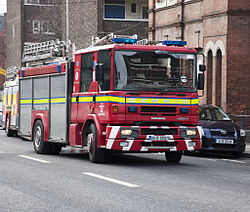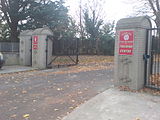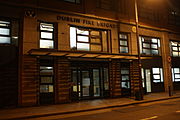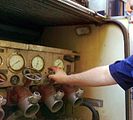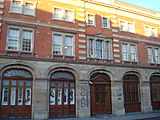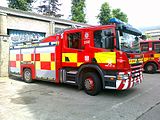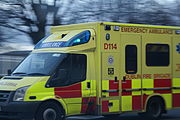- Dublin Fire Brigade
-
Dublin Fire Brigade 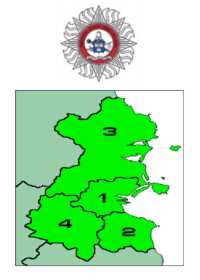
Dublin Fire Brigade areaCoverage Area Dublin City and County Size 355.6 square miles (921 km2) Population 1,000,000+ Operations Formed 1862 HQ Townsend Street, Dublin Staff 900 Stations 14 (includes two retained stations) Chief Fire Officer Hugh O'Neill Deputy Chief Fire Officer Richard Hedderman Website [1] Fire authority Dublin City Council The Dublin Fire Brigade (DFB) (Irish: Briogáid Dóiteán Áth Cliath) is the local authority fire and rescue service for Dublin City and the majority of the Greater Dublin Area. It is a branch of Dublin City Council. There are currently 14 fire stations manned by DFB, 12 of which are full-time, the other 2 are part-time or "retained". Full-time stations are manned by shifts across 4 watches, A, B, C & D. There are currently over 900 active personnel making it the largest fire service based on manpower and resources in the Republic of Ireland.
Contents
History
Dublin City's first municipal fire engines were delivered in 1705. Throughout the second half of the 18th Century, insurance brigades were the primary source of firefighting for the city, operating independently for buildings bearing the mark of their respective insurance companies. Eventually the brigades began to co-operate on a competition basis with the first brigade on scene being the highest paid. It wasn't until 1862 with the enactment of the Dublin Corporation Act, that the city had an organised fire brigade. Dublin man J.R. Ingram became the first superintendent of the brigade, having worked as a fireman in New York and London. The brigade consisted of 24 men with a makeshift fire brigade station on Winetavern Street in The Liberties. In 1898 the Dublin Fire Brigade Ambulance Service was established. The turn of the century saw the brigade have its first fire stations and permanent headquarters built, with the first motorised fire engine coming on stream in 1909.
Stardust fire
In the early hours of the 14th February 1981, Dublin Fire Brigade received a call reporting a fire in the Stardust nightclub in Artane. Units were dispatched from both Kilbarrack fire station and North Strand fire station. When the firemen arrived they were met with scenes of panic, disorder and suffering at what would turn out be the worst fire disaster in the history of the state. 48 people died and 214 people were injured as a result of the fire.
Vehicles and equipment
The Brigade's fleet of vehicles primarily consists of Dennis Sabre Class-B Water Ladder Appliances (WrL) and more recently Scania Class-B WrL's with Dennis RS series and Dennis SS series WrL's still on the run in some districts, water tankers and Dennis and Scania turntable ladder vehicles, aerial platforms and emergency tenders. Specialist vehicles such as foam tenders for assisting the Airport Fire & Rescue Service with aircraft fires & more recently tunnel response vehicles to attend incidents in the Dublin Port Tunnel are also in the fleet. Newer vehicles are based on Scania Chassis, with the marine emergency response unit, command and control unit, an emergency tender and turntable ladder to be the first on this chassis in Dublin. New Scania chassis emergency tenders come pre-equipped with a hiab crane on the tailgate.
Frontline vehicles are equipped with modern firefighting and rescue equipment, including 10.5 metre and 13.5 metre ladders, winches, motorised hosereels, foam inductors, cutting and spreading equipment and earthing equipment (for grounding overhead tram lines).
The majority of the Brigade's ambulances are based on the Ford Transit chassis, with bodywork by Wilker Coachbuilders. Older models (mainly reserve vehicles now in support roles) had Wilker's "Lunar" bodywork, one frontline ambulance and the majority of reserves have "Voyager" bodies while the majority of the frontline fleet have new CEN compliant bodywork. New ambulances are now built on Mercedes Sprinter Chassis with CEN compliant bodywork by Wilker Coachbuilders.
All new District Officer's vehicles are Volkswagen Caravelle MPVs designed to act as mobile command units. These vehicles are gradually replacing the older fleet of Renault Espace MPVs and Ford Mondeos.
Emergency ambulance service
In addition to fire and rescue services, the brigade also operates an emergency ambulance service alongside the HSE National Ambulance Service. Until 2007, all DFB crew were trained to a minimum of PHECC Emergency Medical Technician standard, however in light of changing requirements set down by both PHECC and the HSE, all frontline ambulance personnel are now trained to a minimum of PHECC Paramedic standard. All DFB firefighter-paramedics are required to rotate between fire and ambulance duties. In certain circumstances, a crewed fire appliance may also be despatched to ambulance calls alongside the emergency ambulance (primarily cardiac arrest calls) where additional manpower and support is required. The Brigade also has a small but growing number of Advanced Paramedics, increasing the availability of pre-hospital advanced life support to critically ill patients.[1]
In 2007, The Royal College of Surgeons in Ireland (RCSI) in conjunction with Valentia Technologies, the Dublin Fire Brigade and the Pre-Hospital Emergency Care Council (PHECC) launched a unique training initiative with the Emergency Medical Services Dubai Training Institute. With Dubai EMS using PHECC standards and the DFB training their crews up to those standards.[2]
Training centre & museum
The Dublin Fire Brigade Training Centre is located at the O'Brien Institute on the Malahide Road, Marino, Dublin 3. Recruit firefighter training as well as Paramedic training and specialised courses are held here. The centre also provides various other training courses such as fire marshal training and first aid training to private companies and individuals. The Dublin Fire Brigade museum is also situated at the O'Brien Institute. The museum is operated by firefighter-paramedic Las Fallon and can be visited by appointment.
DFB stations
Full-time stations
Number District Station Fire EMS Specialist Vehicles 1 Alpha Donnybrook 2 Water Tenders, 1 D/O (Alpha District) 13 Ambulance 1 Hazmat Unit 2 Bravo Dolphins Barn 2 Water Tenders, 1 D/O (Bravo District) 14 Ambulance 1 Emergency Tender, 1 Highline Rescue Unit 3 Charlie Phibsboro 2 Water Tenders, 1 D/O (Charlie District) 13 Ambulance 1 Emergency Tender, Reserve Ambulances, 1 Highline Rescue Unit, 1 Water Tanker, 1 Foam Tanker 4 Delta North Strand 2 Water Tenders, 1 Tunnel Response Vehicle (TRV), 1 Foam Tender, 1 D/O (Delta District) 15 Ambulance 1 Foam Support Unit, 1 Tunnel Response Vehicle, 1 Tunnel Support Vehicle, 5 Foxtrot Finglas 1 Water Tender, D/O (Foxtrot District) 17 Ambulance - 6 Delta Kilbarrack 1 Water Tender 100 Ambulance 1 Decontamination Unit 7 Bravo Tallaght 2 Water Tenders 154 Ambulance - 8 Alpha Rathfarnham 1 Water Tender 1356 Ambulance - 9 Charlie Blanchardstown 1 Water Tender 15 Ambulance 1 Major Incident Pod 10 & 11 Echo Tara Street - HQ 2 Water Tenders, 2 Turntable Ladders, 1 D/O (Echo District) 277 Ambulances, 452 Advanced Paramedics 2 Rescue Boats, 1 Boat Response Vehicle, 1 Boat Carrier, 1 Water Tanker, 2 Transport Vehicles, Brigade Support Units 12 Alpha Dun laoghaire 2 Water Tenders, 1 Hydraulic Platform - 1 Reserve Hydraulic Platform 13 Foxtrot Swords 1 Water Tender 51 Ambulance 1 Water Tanker ERCC Echo Eastern Regional Control Centre - TARA ST - - 1 Incident Command Unit OBI Delta O'Brien Institute - Training Centre Fire Training Centre EMS Training Centre (DFB-RCSI) 1 Marine Emergency Rescue Unit, 1 Swift Water Rescue Unit, Training units - Charlie Garage/ Stores - Grange Gorman - - 1 Water Support Unit, Brigade Support Units, Reserve Units Retained Stations
Number District Station Fire 23 Foxtrot Balbriggan 1 Water Tender 24 Foxtrot Skerries 1 Water Tender Defunct stations
Several of the city's original fire stations have closed over time as a result of improved fire prevention systems and the expansion of suburban Dublin.
One of the first pair of stations, at the junction of South William Street (1863) and Coppinger Row, is now the Dublin Civic Museum. The other original station in Winetavern Street (1863) was demolished and the Rathmines and Rathgar station (1914, former public library) at Lower Rathmines Road was most recently manned by Dublin Civil Defence but is now long-closed and semi-derelict.
Many of the following stations were designed by architect C.J. McCarthy and include the Central Fire Brigade Station on Tara Street (built 1906), which was partly de-commissioned when the adjacent Townstend Street opened. Dorset Street Fire Brigade Station (built 1901), Buckingham Street Fire Brigade Station (built 1900) which has been converted into an art studio and Thomas Street Fire Brigade Station (built 1909, funded by the adjacent distillery) which has been restored as an art gallery for the National College of Art and Design.
Gallery
- Dublin Fire Brigade
-
The Dublin Fire Brigade Training Centre at the O'Brien Institute. -
Dolphin's Barn Fire Station (Bravo District) in Dublin 8. -
Pump bay of a Dennis RS series WrL. -
Thomas Street Fire Brigade Station (now part of NCAD). -

The crest of the Dublin Fire Brigade. -
Dublin Fire Brigade Emergency Ambulance arriving at St. James's Hospital with a patient.
References
External links
- Dublin Fire Brigade on Irish Fire Services resource website
- Official Dublin Fire Brigade page
- Pre Hospital Emergency Care Council
Categories:- Organizations established in 1862
- Fire departments
- Fire and rescue services in the Republic of Ireland
- Organisations based in Dublin (city)
- Emergency services in the Republic of Ireland
- Emergency medical services in the Republic of Ireland
Wikimedia Foundation. 2010.

